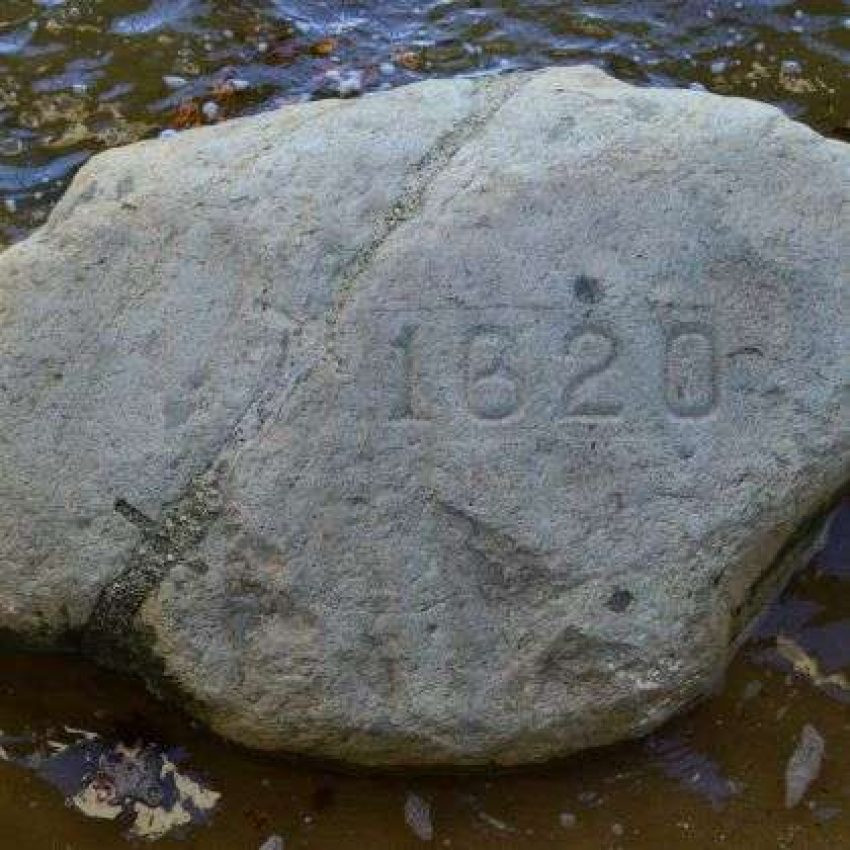Plymouth Rock, a glacial erratic boulder located in Plymouth, Massachusetts, is a powerful symbol of American history and heritage. At rockscapes.net, we’ll explore the rock’s captivating story, from its disputed origins to its enduring legacy as a tangible monument to freedom, attracting over a million visitors each year.
Table of Contents
- What Makes Plymouth Rock So Famous?
- Where Exactly is Plymouth Rock Located?
- When Was Plymouth Rock Identified as the Pilgrims’ Landing Spot?
- Who Identified Plymouth Rock?
- Why is Plymouth Rock Important?
- How Big is Plymouth Rock?
- Has Plymouth Rock Been Damaged or Altered Over Time?
- Can You Touch Plymouth Rock?
- What Else is There to See Near Plymouth Rock?
- What Does Plymouth Rock Represent Today?
- FAQ About Plymouth Rock
1. What Makes Plymouth Rock So Famous?
Plymouth Rock’s fame stems from its long-held association with the arrival of the Pilgrims in 1620. While there’s no concrete historical evidence confirming it as the precise landing spot, the rock has become a powerful symbol representing the Pilgrims’ courage, resilience, and the birth of a new nation. Its fame is also due to a story passed down that a church elder confirmed it was the site.
The rock’s symbolic power transcends its physical presence. It represents the idea of religious freedom, the pursuit of a new life, and the foundations of American democracy. Plymouth Rock has become a national icon, inspiring generations of Americans and visitors worldwide.
Adding to its allure, the rock has been the subject of countless stories, myths, and legends, further solidifying its place in popular culture. It’s a landmark that evokes a sense of history, heritage, and national pride.
 Plymouth Rock Plymouth MA
Plymouth Rock Plymouth MA
2. Where Exactly is Plymouth Rock Located?
Plymouth Rock is located in Pilgrim Memorial State Park, on the shore of Plymouth Harbor in Plymouth, Massachusetts. Pilgrim Memorial State Park is a beautiful location on the shore that includes not just Plymouth Rock, but also provides an evocative setting for reflection on American history.
The park itself is easily accessible and well-maintained, allowing visitors to comfortably view the rock and learn about its history. Its location on the waterfront provides a scenic backdrop, enhancing the overall experience of visiting this iconic landmark.
Address: 79 Water Street, Plymouth, MA 02360
Phone: (508) 747-5360
Visiting Plymouth Rock offers a chance to connect with a pivotal moment in American history. You can almost imagine the Pilgrims stepping ashore after their long and arduous journey.
3. When Was Plymouth Rock Identified as the Pilgrims’ Landing Spot?
Plymouth Rock was identified as the Pilgrims’ landing spot in 1741, 121 years after the arrival of the Mayflower. The specific event that led to this identification was when Thomas Faunce, a 94-year-old church elder, declared the rock to be the exact spot where the Pilgrims first set foot on land.
Faunce claimed that his father, who arrived in Plymouth in 1623, along with several original Mayflower passengers, had assured him of the rock’s significance. His declaration solidified the rock’s place in popular imagination and marked the beginning of its veneration as a national symbol.
Although there is no contemporaneous documentation to confirm Faunce’s claim, it was widely accepted at the time and has since become an integral part of the Plymouth Rock narrative.
4. Who Identified Plymouth Rock?
Thomas Faunce, a 94-year-old church elder, identified Plymouth Rock as the Pilgrims’ landing spot in 1741. According to Faunce, his father, who arrived in Plymouth in 1623, and several original Mayflower passengers vouched for the rock’s significance. His claim was particularly poignant because he made it on the occasion of a wharf being built over the rock.
Faunce’s declaration had a profound impact on the perception of Plymouth Rock. His personal connection to the early settlers added weight to his claim, and it resonated deeply with the community. While lacking definitive proof, Faunce’s identification has been embraced by many and has shaped the rock’s historical narrative for centuries.
 Plymouth Rock Plymouth MA
Plymouth Rock Plymouth MA
5. Why is Plymouth Rock Important?
Plymouth Rock is important because it represents the foundational narrative of the United States. Despite the absence of definitive historical evidence, it symbolizes the Pilgrims’ arrival, their pursuit of religious freedom, and the establishment of a new society based on their values.
The rock’s significance lies in its symbolic representation of these core American ideals. It serves as a tangible reminder of the courage, resilience, and determination of the early settlers who shaped the nation’s identity.
Plymouth Rock has also become a focal point for reflection on American history, prompting discussions about the complexities and nuances of the nation’s past.
6. How Big is Plymouth Rock?
The current visible portion of Plymouth Rock is significantly smaller than its original size. Over the centuries, it has been subjected to various forms of damage and alteration, including being split in two in 1774. One fragment remains on display in Plymouth, while the other is at Pilgrim Hall Museum.
The remaining portion of Plymouth Rock measures approximately:
- 6 feet long
- 3 feet wide
- 1.5 feet high
Despite its diminished size, Plymouth Rock continues to hold immense symbolic weight, serving as a powerful reminder of the nation’s origins.
7. Has Plymouth Rock Been Damaged or Altered Over Time?
Yes, Plymouth Rock has been damaged and altered significantly over time. The rock’s history is marked by several notable incidents:
- Split in 1774: During an attempt to move it to the town square, the rock cracked in two.
- Fragment Removal: Souvenir hunters chipped away pieces of the rock over the years, further reducing its size.
- Cementing: In the 19th century, the rock was cemented together to prevent further damage, which altered its natural appearance.
- Relocation: The rock has been moved several times throughout its history, leading to additional wear and tear.
These alterations have undoubtedly changed the physical appearance of Plymouth Rock.
8. Can You Touch Plymouth Rock?
Unfortunately, you can no longer directly touch Plymouth Rock. It is currently housed inside a protective enclosure to prevent further damage and preserve it for future generations. However, visitors can still view the rock up close and appreciate its historical significance. The enclosure provides a clear view of the rock.
While you can’t touch the rock, the experience of seeing it in person is still deeply moving and allows for a connection with the past.
9. What Else is There to See Near Plymouth Rock?
Besides Plymouth Rock, the town of Plymouth offers several historical and cultural attractions:
- Plimoth Patuxet Museums: A living history museum that recreates the 17th-century Plymouth Colony and a Wampanoag homesite.
- Mayflower II: A full-scale replica of the ship that brought the Pilgrims to America.
- Pilgrim Hall Museum: The oldest continuously operating public museum in the United States, showcasing artifacts from the early Plymouth Colony.
- National Monument to the Forefathers: A towering granite monument dedicated to the Pilgrims and their ideals.
- Downtown Plymouth: A charming area with shops, restaurants, and historical landmarks.
Plymouth offers a rich tapestry of historical and cultural experiences that bring the story of the Pilgrims to life.
 Plymouth Rock Plymouth MA
Plymouth Rock Plymouth MA
10. What Does Plymouth Rock Represent Today?
Today, Plymouth Rock represents a complex and evolving set of meanings. While it continues to symbolize the Pilgrims’ arrival and the founding of America, its significance has expanded to encompass broader themes of:
- Freedom and Liberty: The pursuit of religious freedom and the establishment of a new society based on democratic principles.
- Resilience and Perseverance: The Pilgrims’ ability to overcome hardship and build a new life in a challenging environment.
- Cultural Heritage: A tangible connection to the nation’s past and a reminder of the diverse cultural influences that have shaped American identity.
- Reflection and Dialogue: An opportunity to engage in critical discussions about American history, including both its triumphs and its shortcomings.
Plymouth Rock remains a powerful symbol, inspiring reflection and dialogue about the nation’s past, present, and future.
11. FAQ About Plymouth Rock
Here are some frequently asked questions about Plymouth Rock:
Q1: Is Plymouth Rock the actual rock the Pilgrims stepped on?
There’s no definitive historical evidence to confirm this, but tradition holds that it is.
Q2: Why is Plymouth Rock so small?
It has been damaged, split, and had pieces removed over the centuries.
Q3: Can I visit Plymouth Rock?
Yes, it’s located in Pilgrim Memorial State Park in Plymouth, Massachusetts.
Q4: Is there an admission fee to see Plymouth Rock?
No, access to the park and the rock is free.
Q5: What other historical sites are near Plymouth Rock?
Plimoth Patuxet Museums, Mayflower II, and Pilgrim Hall Museum are nearby.
Q6: Why is Plymouth Rock protected inside an enclosure?
To prevent further damage and preserve it for future generations.
Q7: Has Plymouth Rock ever been moved?
Yes, it has been moved several times throughout its history.
Q8: What is the significance of the year “1620” inscribed on the rock?
It represents the year the Pilgrims arrived in Plymouth.
Q9: Can I take photos of Plymouth Rock?
Yes, photography is allowed.
Q10: Is Plymouth Rock considered a national monument?
It is a part of Pilgrim Memorial State Park, which is a state-owned park, but it is considered a national icon.
Want to incorporate the timeless beauty of natural stone into your own landscape? At rockscapes.net, we offer a wide selection of high-quality stones and expert advice to help you create stunning and enduring outdoor spaces. Contact us today to explore the possibilities. Address: 1151 S Forest Ave, Tempe, AZ 85281, United States. Phone: +1 (480) 965-9011. Website: rockscapes.net.
